Fused Deposition Modeling is a 3D printing technology that creates parts from the plastic filament by melting and then depositing them in layers.
What is Fused Deposition Modeling (FDM)?
Fused deposition modeling is an additive manufacturing technology that creates 3D components using a continuous thermoplastic or composite material thread in filament form. An extruder feeds the plastic filament through an extruding nozzle, which is melted and then selectively deposited layer by layer onto the build platform in a predetermined automated path.
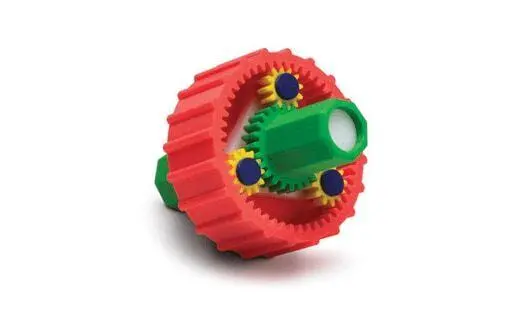
FDM, also known as Fused Filament Fabrication (FFF), is a Material extrusion technology, one of the seven main types of additive manufacturing technologies. FDM is the most widely used 3D printing technique, with the most 3D printer users globally, and is typically the first 3D printing technology to which people are exposed.
Scott Crump pioneered the process in the 1980s under the registered term fused deposition modelling (FDM). Stratasys Inc, a business co-founded by Scott Crump, owns the trademark fused deposition modelling (FDM) and its abbreviation FDM.
How does Fused deposition modeling work?
FDM printer overview
The schematic below shows a basic overview of an FDM printer. It consists of two extruding nozzles on linear slides, a build platform on another linear slide and supports for plastic filament spools.
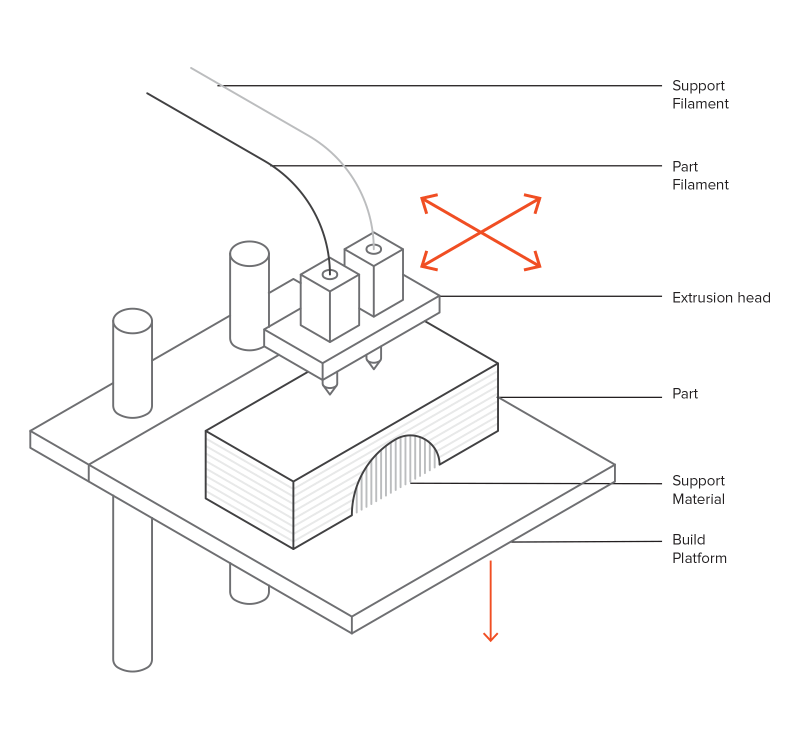
The extruders are called Model and Support extruders. As the name implies, the model extruder prints the material for the 3D shape, while the support extruder prints the supports. They can either have the same material or different materials. Hobbyist printers have a single extruder and use the same material for both model and support.
Depending on the type and brand of FDM printer, the XYZ movement could come from the extruders and the build platform. As the schematic shows, in this version, the extruder head gantry moves in X & Y while the build platform moves in Z-axis. In some versions, the print head moves in X and Z while the build platform moves in Y.
Fused Deposition Modeling process steps
Part preparation step

The first few steps are similar to any other additive manufacturing technology, starting with build preparation software. The initial stage is to import the design file and choose options for the build, such as layer height, orientation and infill percentage. The software then computes sections and slices the part into several layers. The program then creates extruder paths and building instructions based on the sectioning data to drive the extrusion heads.
Depending on the printer and the manufacturer, the above process will be different, but the core step of 3D file conversion into layer-based information is the same.
FDM machine set-up step
The printer is loaded with a thermoplastic filament spool for both model and support extruders. Generally, the build platform is heated and maintained at a higher temperature to control the cooling of the extruded material. Extruders are heated, and when the nozzle reaches the required temperature, the head will start pushing and melting the filament into a small ribbon roughly the size of a human hair.
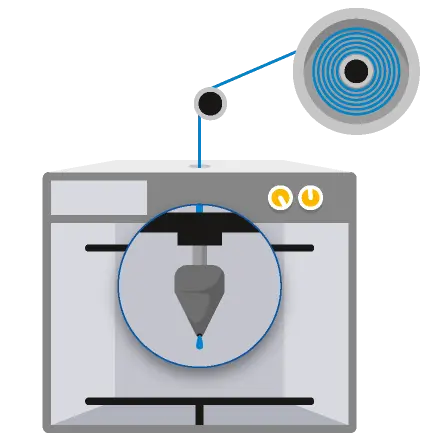
FDM printing step
The extrusion head gantry and the build platform are on a three-axis system, which allows the nozzle tip to move in three directions in space. The extruder will start depositing the material layer by layer in predefined areas to cool and solidify. Sometimes the material cooling is assisted using cooling fans mounted to the extrusion head.
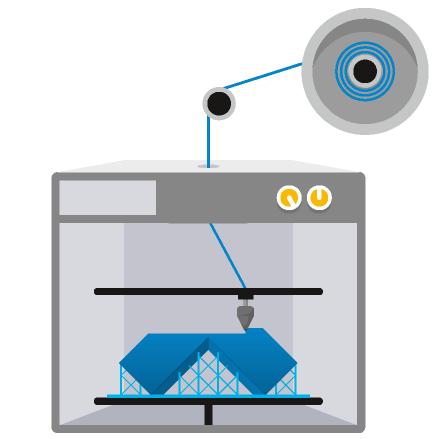
Multiple passes are necessary to fill a region within a layer. When the gantry completes a layer, the build platform or the heads will move the Z-axis by the layer height. Then the above process starts again to deposit a new later. This procedure continues until all the layers are built.
FDM part removal
Like any other 3D printing process, the next stage involves removing parts from the build platform and cleaning them by removing all supports.
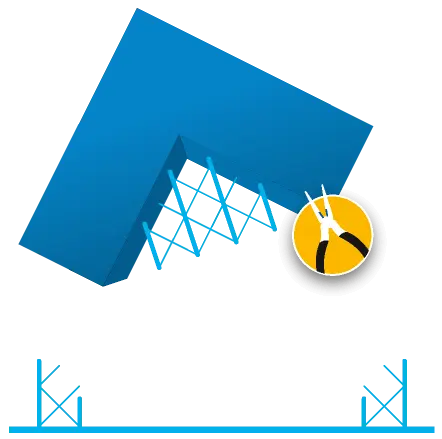
Post-processing
Part can then be further processed, remove any remaining supports and finish to suit the end application.

Characteristics and application of FDM
When using FDM as the manufacturing process, a designer should keep its capabilities and limitations in mind to produce the best results. FDM requires iterative design through prototypes, as features do not usually print the first time correctly.
Temperature and build speed
The nozzle and build platform temperature, build speed, layer height, and cooling fan speed are all adjustable in most FDM systems. The printing service provider often sets these and varies with the material.
Build volume
Build volume is the biggest part the machine can build. A DIY 3D printer’s build volume is typically 200 x 200 x 200 mm, while industrial machines can have build volumes as large as 1000 x 1000 x 1000 mm. Consider the build volume of the printer you will use during the design. Remember, the larger models can also be printed in smaller chunks and might be better for cooling.
Layer height
The layer height used in FDM ranges between 0.02 mm and 0.4 mm. Reduced layer height generates smoother components and more correctly captures curved geometries, but a larger layer height makes parts print faster and at a lesser cost.
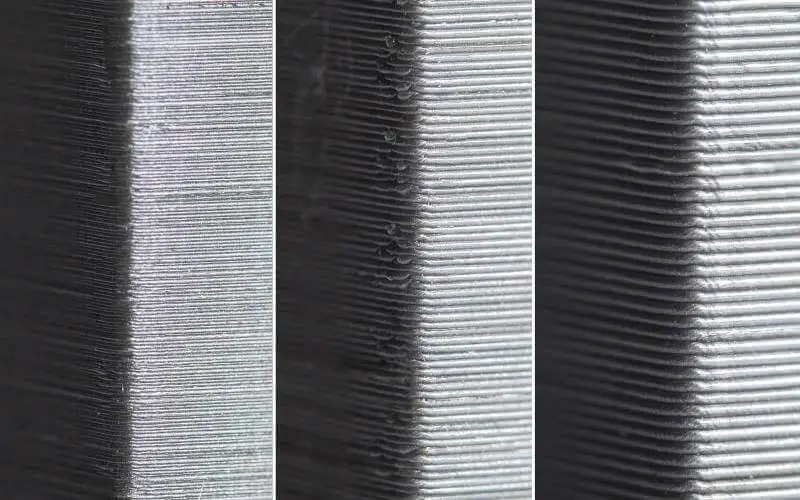
Generally, a layer height of 0.2 mm is a good compromise between cost, time and quality. For low-fidelity rapid prototypes, the increased layer height expedites the process.
Layer Adhesion
For an FDM component, good adhesion between the deposited layers is critical. The molten thermoplastic is forced against the preceding layer as the nozzle extrudes the current. The high temperature and pressure re-melt the surface of the previous layer, allowing the new layer to connect with the previously printed portion. The binding strength between the multiple layers is always less than the material’s base strength.
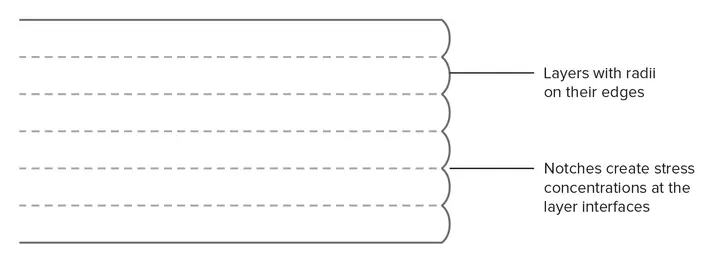
Hence FDM components are anisotropic by nature, and the strength in the Z-axis is always less than their strength in the XY plane. As a result, while designing components for FDM, keeping part orientation in mind is critical, especially for functional parts.
For example, the tensile strength of ABS with 50% infill in the X and Y direction is approximately four times more than in the Z direction. It also stretched about ten times more before breaking.
Furthermore, because the molten material is forced against the preceding layer, it deforms to an oval shape. Hence FDM items will always have a wavy surface, even at low layer height, and that minor features like small holes or threads may require post-processing after printing.
Support Structure
In FDM, geometries with overhangs will require a support structure. The molten thermoplastic cannot be deposited in the absence of air. As a result, some geometries necessitate support structures.
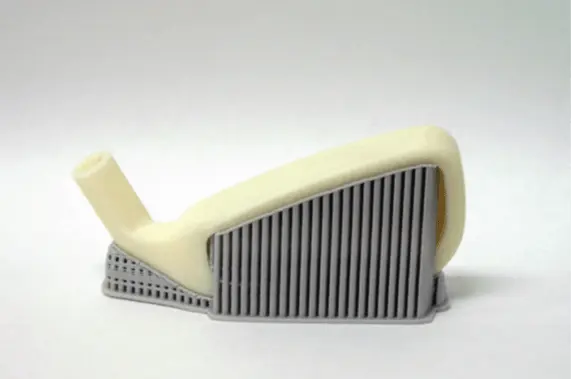
Surfaces printed on supports will have lesser surface quality than the remainder of the item. As a result, it is advised that the part be constructed to minimise the need for assistance.
Typically, support is printed using the same material as the print. In industrial printers, there are other support materials available that can dissolve in liquid. However, they are mostly utilized in high-end desktop or industrial FDM 3D printers. Printing on dissolvable supports enhances the surface quality of the item greatly but raises the total cost of a print due to the need for a dual-head FDM printer and the comparatively high cost of the dissolvable material.
Infill and Shell thickness
FDM pieces are typically not produced solid to save time and material. Instead, the exterior perimeter, known as the shell, is printed using numerous passes, and the inside with an internal, low-density structure, known as the infill.
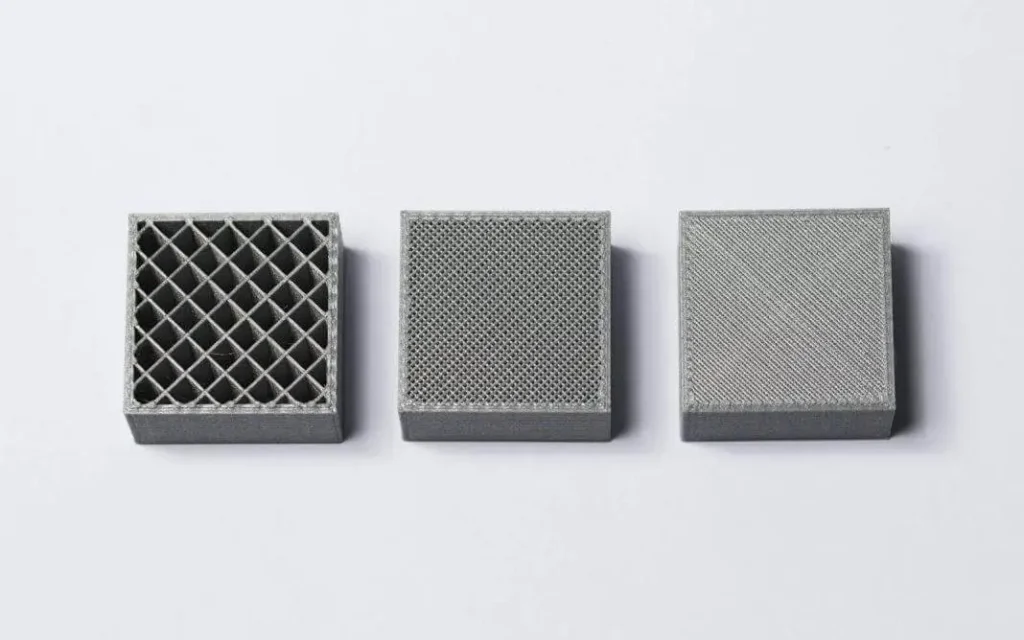
The infill and shell thickness of a print influences the strength of a component.
The default option for desktop FDM printers is 25% infill density and 1 mm shell thickness, a fair balance between strength and speed for rapid prints.
Warping
Warping is one of the most common FDM flaws. The dimensions of the extruded material shrink as it cools during solidification. Because various parts of the print cool at different rates, their dimensions also alter at varying rates. Differential cooling causes internal tensions to build up, pulling the bottom layer higher and causing it to distort.
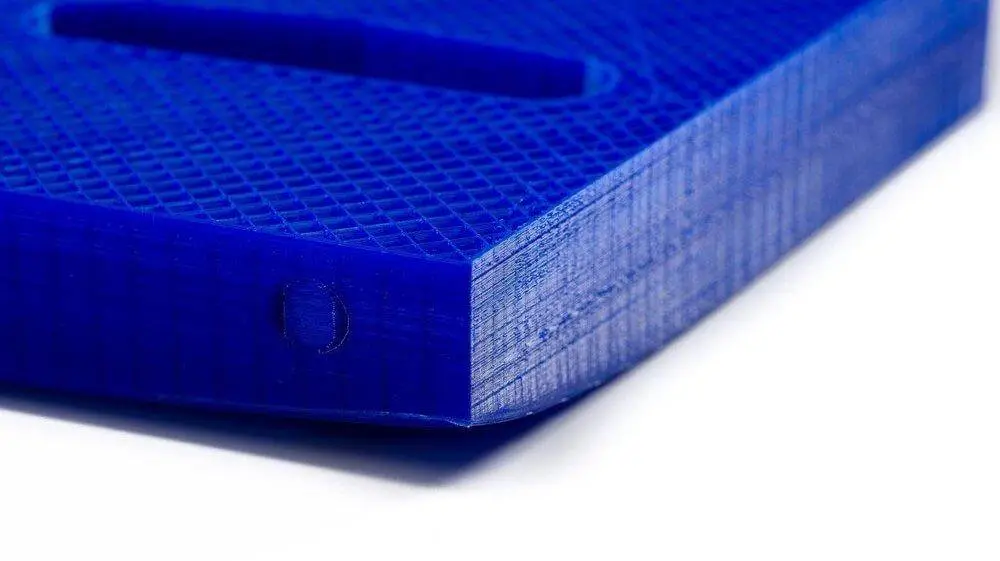
Warping may be avoided by closely monitoring and controlling the temperature of the chamber and the build platform. Good adhesion between the component and the build platform also would help reduce the warping.
Fused deposition modeling advantages and disadvantages
Advantages of FDM
- FDM is the most cost-effective method of manufacturing bespoke thermoplastic components and prototypes.
- Due to the lower cost of FDM printers and wide availability, the lead times are minimal and cheaper than other additive manufacturing processes.
- There is a large variety of thermoplastic materials available for prototyping and certain non-commercial practicals. Most common injection moulding materials can be replicated using FDM
- The technology is aesthetically pleasing, easy to use, and appropriate for the workplace.
- Mechanical and environmental stability are provided by supported production-grade thermoplastics.
- FDM technology makes complex shapes and voids that would otherwise be impractical possible.
Disadvantages of FDM
- When compared to other 3D printing methods, FDM has the lowest dimensional accuracy and resolution, making it unsuitable for items with delicate features.
- Because FDM items are prone to noticeable layer lines, post-processing is essential for a smooth finish.
- Because of the layer adhesion technique, FDM components are inherently anisotropic.
Fused deposition modelling materials
The variety of materials accessible is one of FDM’s primary features. Commodity thermoplastics such as PLA and ABS to engineering materials such as PA, TPU, and PETG. For prototyping, there are high-performance thermoplastics such as PEEK and PEI during the embodiment stages of the new product design.
ABS
ABS-M30 is an excellent material for conceptual modelling, functional prototyping, production tools, and end-use parts. ABS-M30, up to 70% stronger than conventional FDM ABS, is perfect for production components, thermoforming tools, lightweight jigs and fixtures, and concept models. This thermoplastic has high tensile, impact, and flexural strength. Sparse or solid fill is available.
- Pros – Offers good strength, good temperature resistance
- Cons – More susceptible to warping
PC
PC (polycarbonate) is widely used in the automotive, aerospace, and medical industries, among many others. PC provides precision, durability, and stability, resulting in sturdy parts that resist functional testing. Rapid tooling, jigs and fixtures for production
- Pros – Accurate, Rigid, Stable, RF transparent, High tensile and flexural
- Cons – Not widely available, higher cost
PC-ABS
PC-ABS combines the best qualities of both PC and ABS materials, such as strong strength with the heat resistance of PC and the flexibility of ABS. PC-ABS composites are widely used in automotive, electronics, and telecommunications applications. Form fit and functional prototypes, low-volume production parts
- Pros – High impact strength, High heat resistance
- Cons -Not widely available, higher cost
PLA
PLA is a bioplastic and is one of the standard materials for this technology, along with ABS (Acrylonitrile Butadiene Styrene).
- Pros – Excellent visual quality, Easy to print with
- Cons- Low impact strength
Nylon
Nylon is one of the most widely used commercial FDM materials, and it possesses a good combination of tensile strength and toughness. Generally used for rapid prototyping concept validation models, prototype parts for visual design validation, and production toolings such as jigs, fixtures, and manufacturing aids. It can also be used for low-volume production parts with less demanding functional parts.
- Pros – High strength, Excellent wear, and chemical resistance
- Cons – Low humidity resistance
PETG
- Pros – Food safe although grooves and grannies of notches between the layers are a critical point for bacterial growth, good strength, easy to print
- Cons – Not widely available, higher cost
TPU
TPU 92A FDM Elastomer is a thermoplastic polyurethane substance used to make long-lasting elastomer components. The material allows for the development of high-functioning, long-lasting, and complicated parts with the anticipated material features of an elastomeric material, such as enhanced tear resistance, fatigue resistance, and memory recovery.
- Pros – Very flexible, good toughness, Durable, Abrasion resistance
- Cons – Difficult to print accurately
PEI
- Pros – Excellent strength-to-weight ratio, Excellent fire and chemical resistance
- Cons – High cost
Applications and uses of FDM
What may FDM 3D Printing be used for? Although the options for product creation and manufacture are limitless, the majority of applications fall into four broad categories:
- Functional prototypes
- Production and manufacturing tools
- Concept models
- Production quality parts
No comments:
Post a Comment